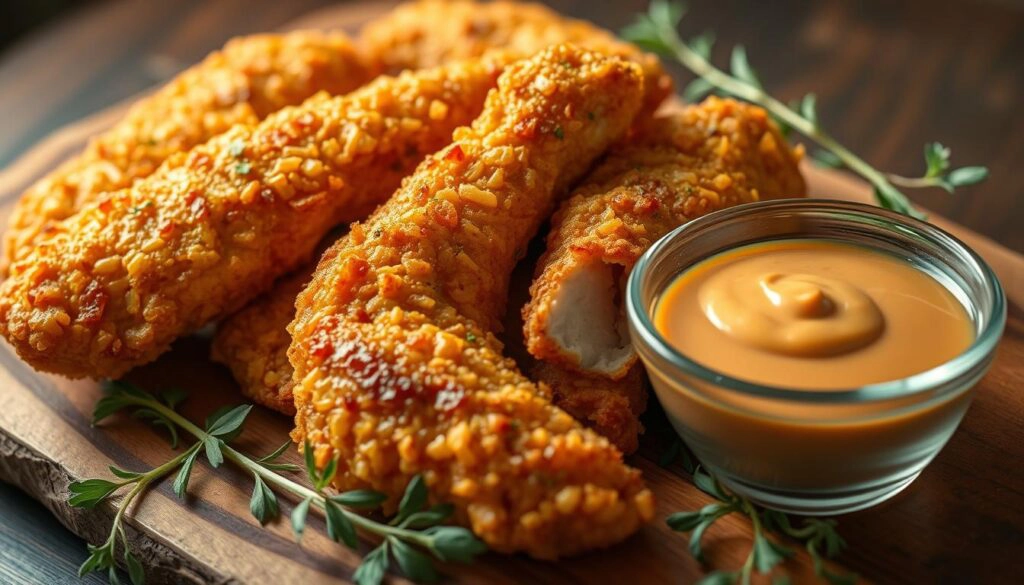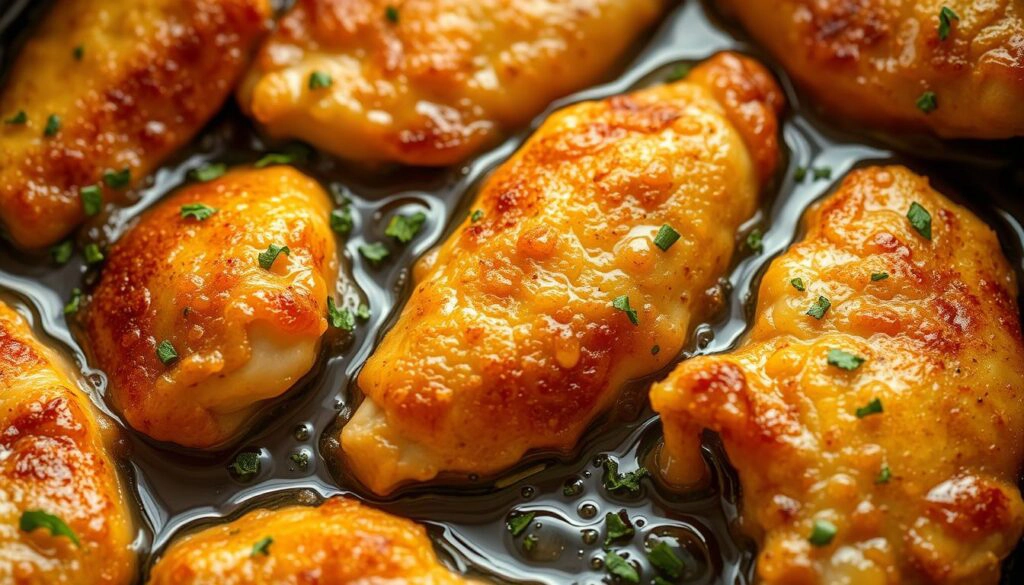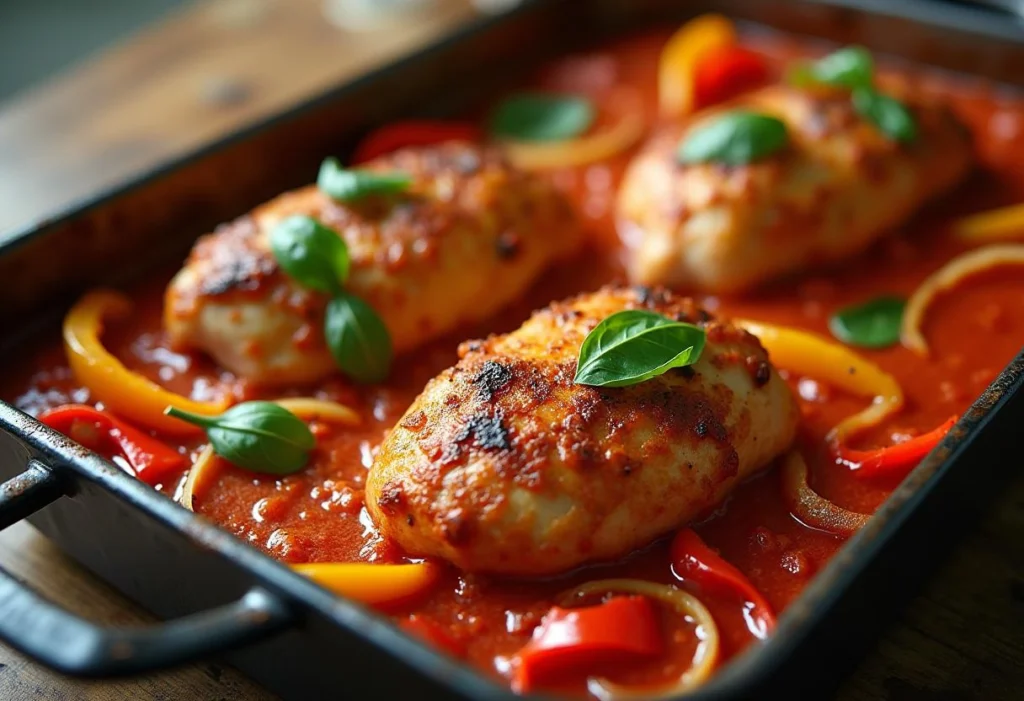How Do You Keep Chicken Tenders Juicy When Frying ?

Frying chicken tenders can be tricky. You want them to be crispy on the outside but still juicy on the inside. How do you keep chicken tenders juicy when frying? The secret lies in using the right techniques to lock in moisture while achieving that perfect golden crust. By understanding these methods, you can ensure your fried chicken tenders turn out flavorful and tender every time.
We’ll share the best ways to make sure your fried chicken tenders are always juicy, from proper seasoning and breading techniques to maintaining the perfect frying temperature. These simple tricks will take your homemade chicken tenders to the next level.
Understanding the Science Behind Juicy Chicken Tenders
To make chicken tenders juicy and tasty, you need to balance protein denaturation, moisture, and fat. Let’s explore the science behind these key elements.
The Role of Protein and Moisture Retention
Chicken tenders are mostly protein. How these proteins act when cooked affects their texture and juiciness. When chicken is heated, its proteins change, which can affect how much moisture it keeps.
👉 Related Reading: Can I Put Raw Chicken in My Air Fryer? A Complete Guide
Temperature Control and Moisture Loss
Temperature is crucial for keeping chicken tenders moist. If the chicken is heated too fast, the outside can get too crispy and the inside dry. By controlling the temperature, you can cook the chicken slowly.
👉 Related Reading: Should I Fry Chicken in Butter or Oil?
Fat Content and Juiciness Correlation
The fat in chicken tenders also affects their juiciness. Fats help slow down moisture loss when cooking. With the right amount of fat, chicken tenders stay moist and tender, even after frying.
“Balancing protein behavior, temperature control, and fat content is the secret to achieving juicy, flavorful chicken tenders every time.”
Essential Ingredients for Keeping Chicken Tenders Juicy When Frying
Making juicy and tasty chicken tenders begins with the right ingredients. The quality of the chicken and the mix of seasonings and brine are key. Each part is important for a great meal.
The base of any top chicken tender is the chicken itself. Choose fresh, high-quality chicken breasts or tenderloins. Make sure they look good and are free of any flaws. The better the chicken, the juicier and tender it will be.
Seasoning your chicken tenders with the right spices and herbs can make a big difference. Try a mix of salt, pepper, garlic powder, and paprika. Or, go for something bolder like cajun seasoning or lemon-pepper. The goal is to match the chicken‘s natural sweetness.
The secret to juicy chicken tenders is the brine. A good brine, with salt, sugar, and aromatics, keeps moisture in and makes the chicken tender. Try adding fresh herbs, citrus, or vinegar to your brine for a unique flavor.
By focusing on the chicken quality, the right seasonings, and a balanced brine, you can make perfectly juicy and flavorful chicken tenders every time.
The Important Role of Brining in Moisture Retention
Getting juicy and flavorful chicken tenders is more than just frying. The secret is in the brining process. Both wet and dry brining are key to keeping the chicken moist and adding great flavors.
Wet Brining Methods and Timing
Wet brining means soaking the chicken tenders in a saltwater mix for a while. This helps the meat soak up the brine, keeping it moist and seasoned. The right wet brining time can be anywhere from 30 minutes to hours, based on the tenders’ thickness.
Dry Brining Techniques
Dry brining coats the chicken in a dry salt mix and lets it sit before cooking. It draws out juices, which then get reabsorbed, making the chicken juicier and tastier. Dry brining time can range from 30 minutes to 24 hours, depending on the tenders’ size.
Seasoning Your Brine for Extra Flavor
- Boost your wet brine or dry brine with herbs, spices, or citrus zest for a tasty flavor infusion.
- Try adding garlic, rosemary, thyme, or lemon to make your chicken tenders truly special.
- The longer you brine, the stronger the flavor will be. So, adjust the time to match your taste.
Learning about brining and using these methods can help you make juicy, flavorful chicken tenders. Your taste buds will thank you.
How Do You Keep Chicken Tenders Juicy When Frying? Expert Tips for Moist and Crispy Results
To make chicken tenders juicy and flavorful, you need to know a few tricks. It’s all about controlling the temperature and keeping moisture in. This knowledge helps you get tender, juicy results every time.
Mastering the Art of Frying Techniques
Keeping chicken tenders moist and juicy starts with your frying methods. The right temperature control is key. It seals in juices and gives a crispy outside. Also, using brining or coating helps a lot with moisture retention.
“The secret to juicy chicken tenders lies in the delicate balance of frying techniques, temperature management, and moisture preservation.”
Learning these key points can take your fried chicken tenders to the next level. It will please even the pickiest eaters.

Balancing Temperature and Time
When frying chicken tenders, temperature control is essential. Keeping the oil at 350°F to 375°F ensures a crispy outside and juicy inside. Watch the frying time and adjust the heat to avoid overcooking.
| Frying Temperature | Ideal Frying Time |
|---|---|
| 350°F – 375°F | 3-5 minutes per batch |
Getting the temperature and time just right gives you a golden-brown outside and juicy meat inside.
Proper Oil Temperature Management Techniques
Keeping the oil at the right temperature is key for juicy chicken tenders. The oil’s temperature helps keep the meat moist and tender.
Best Oils for Frying Chicken
Some oils are better for frying chicken than others. Peanut oil, vegetable oil, and canola oil are top choices. They can handle high heat without burning or adding bad flavors.
Temperature Monitoring Methods
- Use a digital kitchen thermometer to watch the oil temperature. Aim for 350°F to 375°F.
- An analog frying thermometer is also good for checking the oil temperature while cooking.
👉 Related Reading: Chicken Fries in the Air Fryer: A Crispy & Delicious Guide
Maintaining Consistent Heat
To keep the frying oil at a steady temperature, follow these tips:
- Heat the oil to the right temperature before adding chicken tenders.
- Adjust the heat as needed to stay in the target range.
- Don’t overcrowd the pan, as it can lower the oil temperature.
- Let the oil get back to the right temperature between batches.
By managing the oil temperature well and using the right thermometer, your chicken tenders will always be juicy and tasty.
Coating and Breading Secrets for Keeping Chicken Tenders Juicy When Frying
Getting juicy and crispy chicken tenders starts with the right breading. The secret to a moisture-locking coating is key. We’ll explore the essential breading methods for moist and tasty chicken tenders.
Start with a three-step breading station. First, mix your flour mixture with salt, pepper, and spices. Then, whisk eggs with water or milk for the egg wash. Lastly, prepare your breading, like panko breadcrumbs or a mix of breadcrumbs and cornmeal.
- Dredge the chicken tenders in the seasoned flour mixture, covering all sides evenly.
- Dip the floured tenders into the egg wash, letting excess drip off.
- Press the chicken into the breading for a thick, crispy coat.
The secret to keeping moisture in is the mix of flour mixture, egg wash, and breading. The flour stops moisture loss. The egg wash helps the breading stick. And the breading seals in the juices.

“The secret to juicy, crispy chicken tenders is all in the breading. Follow these steps, and you’ll be a fried chicken master in no time.”
Try different breading techniques and flavors to create your own style. The perfect mix of moisture and crispiness makes great fried chicken tenders.
Timing and Flipping Techniques for Keeping Chicken Tenders Juicy When Frying
Frying chicken tenders right means getting a crispy outside and a juicy inside. You need to know when they’re done and how to flip them. This two-step frying method is key to making delicious fried chicken tenders.
Visual Cues for Perfect Doneness
Knowing when chicken tenders are done is crucial. Look for a golden-brown color and a crisp texture. Use a digital thermometer to check the inside reaches 165°F (74°C). This ensures they’re safe and juicy.
The Two-Step Frying Method
- Start by frying the chicken tenders at 350-375°F (177-191°C) for a few minutes. This step makes the outside crispy and locks in the juices.
- Then, lower the temperature to 325-350°F (163-177°C) and fry until they’re fully cooked. This method prevents the outside from burning while the inside cooks evenly.
- Flip the chicken tenders halfway through frying. This ensures they cook evenly and turn golden-brown on all sides.
By using the two-step frying method and watching for visual cues, you can make chicken tenders that are juicy inside and crispy outside every time.
“The key to perfectly fried chicken tenders is all about timing and technique. Master the two-step fry and you’ll be well on your way to juicy, craveable results.”
Resting and Serving Tips for Keeping Chicken Tenders Juicy When Frying
After frying chicken tenders, the journey to juicy perfection isn’t over. The secret to keeping them moist lies in resting and serving them correctly.
Let your fried chicken tenders rest for a few minutes. This step is key for moisture retention. It lets the juices spread evenly, making the meat juicy and tender. This brief pause stops the loss of moisture that happens if you eat them right away.
- Give your fried chicken tenders a 5-10 minute rest on a wire rack or paper-lined plate.
- This resting period allows the internal temperature to stabilize and the juices to reabsorb into the meat.
- Resist the temptation to cut into the tenders right away, as this can release all the flavorful juices.
When it’s time to serve, present your juicy fried chicken tenders on a warm platter or plate. This keeps the serving temperature right and lets everyone enjoy every bite at its best.
“The secret to perfectly juicy fried chicken tenders lies in the art of resting and serving.”
Follow these simple tips to serve fried chicken tenders that are full of moisture retention and flavor. Your family and friends will be impressed.
Common Frying Mistakes to Avoid for Keeping Chicken Tenders Juicy When Frying
Making juicy and tender chicken tenders is a delicate task. It’s easy to make mistakes that can make them dry and disappointing. Let’s look at some common errors to avoid for moist and tasty fried chicken tenders.
Temperature Control Errors
Improper temperature control is a big reason for dry chicken tenders. Overcooking the chicken takes away its moisture, leaving it dry and tough. It’s important to keep an eye on the oil temperature and adjust it as needed. The ideal temperature is between 350°F and 375°F.
Frying at too low a temperature can also cause problems. It leads to longer cooking times and more moisture loss. Keeping the oil temperature right is crucial for sealing in juices and getting that perfect crispy crust.
Breading Problems to Avoid
Improper breading can also make chicken tenders dry. Using too little breading or a thin coating lets juices escape during frying. On the other hand, too much breading can prevent heat from getting to the chicken, keeping it moist.
It’s important to find the right balance with your breading. Aim for a medium-thickness coating that crisps up well while keeping the chicken’s juices in. Paying attention to your breading technique is key to the final texture and moisture of your fried chicken tenders.
By avoiding these common mistakes and improving your temperature control and breading, you’ll make juicy and flavorful fried chicken tenders. Your family and friends will love them.
FAQ: How to Keep Chicken Tenders Juicy When Frying
What are the best oils for frying chicken tenders?
For frying chicken tenders, use oils with high smoke points. Peanut, canola, or vegetable oil works well. They handle high temperatures, making the outside crispy and the inside juicy.
How do I properly brine chicken tenders to retain moisture?
Brining is key for moist chicken tenders. You can use a wet brine by soaking the chicken in saltwater. Or, try dry brining with salt on the meat. Both methods help keep the chicken moist during frying.
What are some key techniques for maintaining consistent oil temperature when frying chicken tenders?
Keeping the oil temperature steady is crucial. Use a thermometer to check the temperature. Adjust it as needed to stay within the best range. Don’t overcrowd the pan to avoid temperature drops. The two-step frying method also helps with even cooking.
Final Thoughts on Keeping Chicken Tenders Juicy When Frying
In this article, we explored how to keep chicken tenders juicy and tasty when frying. We covered the science of keeping them moist and how to control temperature and breading. Now, you know how to make your chicken tenders as good as those in a restaurant.
Using brining, managing oil temperatures, and mastering coating and frying are key. These steps help avoid dry, tasteless chicken. The goal is to get a crispy outside and a juicy inside, a balance that needs care and practice.
Try out these tips and techniques for juicy chicken tenders. Your family and friends will love them. You’ll impress everyone with your fried chicken skills. Get ready to enjoy crispy, golden chicken that’s also juicy and full of flavor.







4 Comments